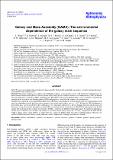Files in this item
Galaxy And Mass Assembly (GAMA) : the environmental dependence of the galaxy main sequence
Item metadata
| dc.contributor.author | Wang, L. | |
| dc.contributor.author | Norberg, P. | |
| dc.contributor.author | Brough, S. | |
| dc.contributor.author | Brown, M. J. I. | |
| dc.contributor.author | da Cunha, E. | |
| dc.contributor.author | Davies, L. J. | |
| dc.contributor.author | Driver, S. P. | |
| dc.contributor.author | Holwerda, B. W. | |
| dc.contributor.author | Hopkins, A. M. | |
| dc.contributor.author | Lara-Lopez, M. A. | |
| dc.contributor.author | Liske, J. | |
| dc.contributor.author | Loveday, J. | |
| dc.contributor.author | Grootes, M. W. | |
| dc.contributor.author | Popescu, C. C. | |
| dc.contributor.author | Wright, A. H. | |
| dc.date.accessioned | 2019-10-16T16:30:03Z | |
| dc.date.available | 2019-10-16T16:30:03Z | |
| dc.date.issued | 2018-10 | |
| dc.identifier | 261907252 | |
| dc.identifier | a5f5149d-b98c-405a-985c-8d5188f25e99 | |
| dc.identifier | 85055140091 | |
| dc.identifier.citation | Wang , L , Norberg , P , Brough , S , Brown , M J I , da Cunha , E , Davies , L J , Driver , S P , Holwerda , B W , Hopkins , A M , Lara-Lopez , M A , Liske , J , Loveday , J , Grootes , M W , Popescu , C C & Wright , A H 2018 , ' Galaxy And Mass Assembly (GAMA) : the environmental dependence of the galaxy main sequence ' , Astronomy & Astrophysics , vol. 618 , A1 , pp. 1-6 . https://doi.org/10.1051/0004-6361/201832697 | en |
| dc.identifier.issn | 0004-6361 | |
| dc.identifier.other | ArXiv: http://arxiv.org/abs/1802.08456v1 | |
| dc.identifier.uri | https://hdl.handle.net/10023/18693 | |
| dc.description.abstract | Aims: We aim to investigate if the environment (characterised by the host dark matter halo mass) plays any role in shaping the galaxy star formation main sequence (MS). Methods: The Galaxy and Mass Assembly project (GAMA) combines a spectroscopic survey with photometric information in 21 bands from the far-ultraviolet (FUV) to the far-infrared (FIR). Stellar masses and dust-corrected star-formation rates (SFR) are derived from spectral energy distribution (SED) modelling using MAGPHYS. We use the GAMA galaxy group catalogue to examine the variation of the fraction of star-forming galaxies (SFG) and properties of the MS with respect to the environment. Results: We examine the environmental dependence for stellar mass selected samples without preselecting star-forming galaxies and study any dependence on the host halo mass separately for centrals and satellites out to z ∼ 0.3. We find the SFR distribution at fixed stellar mass can be described by the combination of two Gaussians (referred to as the star-forming Gaussian and the quiescent Gaussian). Using the observed bimodality to define SFG, we investigate how the fraction of SFG F(SFG) and properties of the MS change with environment. For centrals, the position of the MS is similar to the field but with a larger scatter. No significant dependence on halo mass is observed. For satellites, the position of the MS is almost always lower (by ∼0.2 dex) compared to the field and the width is almost always larger. F(SFG) is similar between centrals (in different halo mass bins) and field galaxies. However, for satellites F(SFG) decreases with increasing halo mass and this dependence is stronger towards lower redshift. | |
| dc.format.extent | 6 | |
| dc.format.extent | 1347896 | |
| dc.language.iso | eng | |
| dc.relation.ispartof | Astronomy & Astrophysics | en |
| dc.subject | Galaxies: abundances | en |
| dc.subject | Galaxies: star formation | en |
| dc.subject | Galaxies: statistics | en |
| dc.subject | Galaxies: evolution | en |
| dc.subject | Galaxies: groups: general | en |
| dc.subject | Galaxies: halos | en |
| dc.subject | QB Astronomy | en |
| dc.subject | QC Physics | en |
| dc.subject | NDAS | en |
| dc.subject.lcc | QB | en |
| dc.subject.lcc | QC | en |
| dc.title | Galaxy And Mass Assembly (GAMA) : the environmental dependence of the galaxy main sequence | en |
| dc.type | Journal article | en |
| dc.contributor.institution | University of St Andrews. School of Physics and Astronomy | en |
| dc.identifier.doi | 10.1051/0004-6361/201832697 | |
| dc.description.status | Peer reviewed | en |
| dc.identifier.url | http://arxiv.org/abs/1802.08456 | en |
This item appears in the following Collection(s)
Items in the St Andrews Research Repository are protected by copyright, with all rights reserved, unless otherwise indicated.

